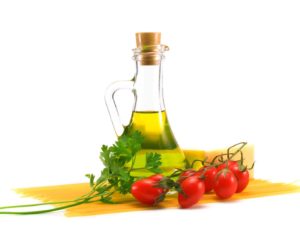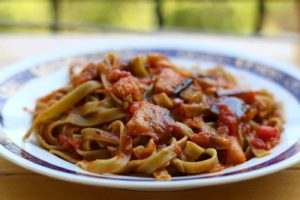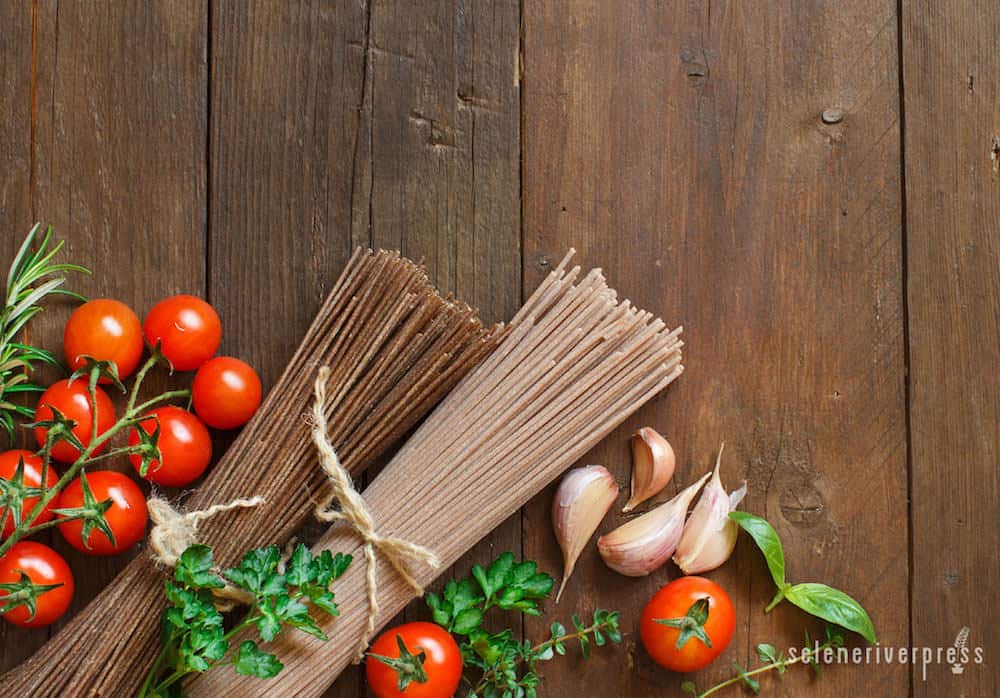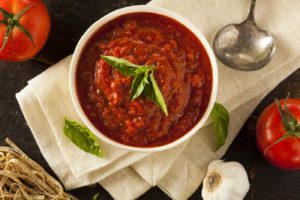Heaven forbid that we should mention pasta. Why? Because the refined version is fattening, and it’s chock-full of simple carbohydrates and empty calories. In addition, the flour hasn’t been prepared properly by soaking it for easy digestion.
To be honest, I’d not even thought of pasta for many years. But when a memory brought it to mind, I was encouraged to research and write about it. Recently reminiscing about some of the best days of my childhood, I recalled a warm, inviting scene of stuffing my mouth with the most awesome meal prepared by Mrs. Mello, an immigrant Italian neighbor who lived not too far from us: bread, fresh salad with homemade Italian dressing, and yes, a huge bowl of spaghetti with traditional spaghetti sauce.
 To the dismay of our mothers, many of us frequently headed to Mrs. Mello’s house after school to see what great Italian entrée was on her stove. We’d lick our chops, never knowing she used chicken feet!! To make her spaghetti sauce! Yes, those were the good ole, happy, innocent days. (Smile.)
To the dismay of our mothers, many of us frequently headed to Mrs. Mello’s house after school to see what great Italian entrée was on her stove. We’d lick our chops, never knowing she used chicken feet!! To make her spaghetti sauce! Yes, those were the good ole, happy, innocent days. (Smile.)
Forward many years. Sadly, I now rarely dine at Italian restaurants, let alone fix pasta at home. Nevertheless, feeling hunger pangs for Mrs. Mello’s fine pasta dishes, I decided to reintroduce those flavors back into my life, at least occasionally. Welcome to the winding twists and turns I encountered on my quest to find nutrient dense pasta and put it into rotation along with my other healthy meals of grass-fed beef, wild-caught salmon, RNA-rich sardines, sourdough breads, and other food that now make up most of my diet.
Obstacles I Encountered and How I Resolved Them
As I searched for ready made, organic, whole grain pasta like spaghetti and lasagna, I tried to keep in mind the criteria for grain based products set forth in Sally Fallon’s Nourishing Traditions:
- The flour used to make ready made pasta is soaked to remove phytic acid.
- The flour comes from organically grown grains.
- The pasta is soy free.
- The pasta comes in gluten free options as well organic wheat, spelt, einkorn, or emmer pastas for those not on a gluten free diet.
Needless to say, my dream of ever tasting a nutrient dense pasta grew dim as I went from one rabbit hole (website) to another. (Sigh.) But please allow me to make a brief departure from my pasta hunting adventures as some readers may not be familiar with phytic acid.
Why We Want Our Diets Free of Phytic Acid
One of the many nutritional techniques you first learn from the Weston A. Price Foundation is to soak your grains, legumes, and nuts to neutralize the phytic acid. This is important because phytic acid can inhibit the absorption of iron, zinc, and calcium, and it may promote other mineral deficiencies. Phytic acid is therefore considered by many to be an anti-nutrient. Even knowing this, many people still don’t soak their grains or whole grain flour before using it. Free will, you know. (Tongue in cheek!)
Returning to My Search for Ready Made Whole Grain Pasta
After an afternoon of searching for ready made whole grain pasta that meet the Nourishing Traditions criteria above, I found myself wasting way too much time going from one website to another. Below I list two that don’t pass muster. Nevertheless, both are great companies. Use their product with the knowledge that they don’t meet the criteria I’m personally looking for, though I surely wish they did.
Food for Life Baking Company: Nice variety, but unfortunately the pasta contains soy, which is not approved in any form in the Weston A. Price Shopping Guide.
TruRoots Ancient Grain Pastas: Nice selection, but they offer no organic wheat, spelt, einkorn, or emmer. They use organic brown rice flour, organic quinoa flour, organic amaranth flour, and organic corn flour. If you’re looking for those types of flours, this is the place to go.
Though at this point I still wasn’t able to find a company that makes a full compliment of ready made whole grain pasta that met my criteria, I did find some limited resources for sprouted, soaked, phytic-acid free flour. However, they didn’t meet all the criteria. The kicker in this case is that, although you can get some variations of sprouted flour, you’re still left with the task of making the pasta!! Many traditional cooks do just that. But I humbly admit that I have neither the time nor the inclination to make my own pasta—at least at this time. (Smile.)
Bridging the Gap: Finally, a Sensible Answer
As a last resort, I decided to ask what others might be doing to include healthy pasta in their diet. With that in mind, I mentioned my dilemma to my great group of WAPF chapter leaders. To my surprise, Kris, a longtime chapter leader and retired RN, sent me this message:
Maria:
You may be overly concerned about phytate. This article has links to research showing some benefits of phytate. It also says that for meat eaters, the binding of iron and zinc that it causes is of little concern as it doesn’t affect the iron and zinc in meat, which is the better, more readily absorbed source anyway. Some occasional pasta isn’t the end of the world, unless you are vegetarian and eat too many un-soaked grains.
With great joy and an enlightened mind, I gladly present to you some great, ready-to-use, whole grain pasta (albeit un-soaked) for that long overdue pasta meal. I’ve also included a few recipes from yesteryear, but I use organic whole grains! (As a side note, this would be a great opportunity for someone to start what I believe would be a thriving business.)
Nutrient Dense Qualities of Whole Grain Pasta
Due to the many scary articles about grain out there, many of us have even quit eating bread—including whole grain bread—which was one of the primary means by which our ancestors reaped the wondrous nutritional components of heritage grains. I write about this very subject in an article published in the Wise Traditions Journal titled “To Gluten or Not to Gluten,” which is posted at my website.
The Whole Grains Council has well-detailed charts and nutritional information. Please visit them to learn more. A quick list of nutrients in organic whole grains includes: protein, fiber, iron, magnesium, phosphorus, zinc, copper, manganese, selenium, thiamin (B1), riboflavin (B2), niacin (B3), pyroxidine (B6), and folic acid (B9).
Ready Made (Unsoaked, Not Phytic-Free) Whole Grain Pasta Sources
Below are three sources for the most popular whole grain pastas (spelt, whole wheat, and einkorn). And although they don’t make pasta, I felt that Organics by Lee is a must-mention website. Last, but certainly not least, I found a very interesting new sprouted flour product, Super Sprout™, which you may want to try if you make your own baked goods.
Nature’s Legacy: One of my favorites. Nature’s Legacy specializes in spelt, which is considered a lower-gluten grain. Please note that they carry both refined white and whole grain spelt pastas. Choose the whole grain spelt to ensure you get the full nutrient value of this ancient grain.
Jovial: One of the first to offer whole grain einkorn berries, which I believe are grown in Italy. Now it looks like Jovial is also making pasta, and I’m looking forward to trying it out. They also offer gluten free choices. Another premium einkorn and emmer supplier is Bluebird Grain Farms. Since their grains are grown in the United States, I often purchase my einkorn berries or flour from them.
Delallo: Offers a relatively large assortment of organic whole wheat pastas. I’ve not used their product, but I’ve seen it in my health food stores and will certainly be trying it out.
Organics by Lee: Although this company doesn’t make ready made pastas at this time, I think it’s important to list the website for anyone who may be looking to make their own pasta. Organics by Lee carries pristine organic grains and the newest, most efficient grain mill to date. The company is approved by the Weston A. Price Foundation and will be listed in the 2017 Find Real Food app and shopping guide.
Ready Made, Sprouted, Phytic-Free, Whole Grain Flour Sources
Lindley Mills Super Sprout™: This was a new discovery for me. The company utilizes a proprietary process to sprout, stabilize, and mill their organic whole grain wheat into a soft, silky-fine baking flour they call Super Sprout™. Learn more about the Super Sprout difference™ regarding improved flavor, performance, and nutrition.
Yummy, Traditional Italian Pasta Recipes
SPAGHETTI SAUCE WITH CHICKEN FEET AND MARROW BONES
—Adapted from Learning and Yearning. Talk about gelatin rich!
Ingredients
At least 3–4 beef bones with marrow
2–3 tablespoons olive oil or tallow
½–1 cup chopped onions
3–4 cloves minced garlic
Several chicken feet (these add collagen and flavor)
2 quarts home-canned tomatoes, strained through a food mill
1 (7 oz.) jar organic tomato paste
2–3 tablespoons oregano
2–3 tablespoons basil
2–3 tablespoons parsley
¼ teaspoon nutmeg
2 teaspoons sea salt (or to taste)
Pepper to taste
Instructions
- First, roast the bones in a 350°F oven for 45–60 minutes.
- While the bones are roasting, sauté the chopped onion in olive oil or tallow over low heat. When the onion begins to become translucent, add the minced garlic. Sauté a minute or two longer.
- Add the remaining ingredients, including the roasted bones when they’re done, making sure to scrape every last drop of drippings from the pan to the sauce.
- Simmer slowly for several hours. The gelatin from the bones and the chicken feet will help to thicken the sauce and give it wonderful flavor.
SIMPLE WHOLE WHEAT SPAGHETTI
—Adapted from Martha Stewart. For this dish, you may also use the spaghetti sauce above.
Ingredients
Celtic salt
8 oz. whole wheat, spelt, einkorn, or other whole grain spaghetti
2 teaspoons olive oil
1 garlic clove, thinly sliced
Pinch red pepper flakes
¼ cup fresh flat-leaf parsley
Instructions
- In a large pot of boiling salted water, cook spaghetti until al dente, according to package instructions. Reserve 1 cup pasta water. Drain pasta and set aside.
- In pasta pot, heat oil, garlic, and red-pepper flakes over medium until garlic has begun to brown, about 2 minutes. Add reserved pasta water, then spaghetti and parsley. Season with salt. Toss to combine.
TRADITIONAL ITALIAN SALAD DRESSING
—From “The Best Ever Classic Italian Salad Dressing” by Bruce Bradley. Makes 1½ cups or about twelve (2 tablespoon) servings.
Ingredients
½ cup vinegar (white wine, red wine, or balsamic are our favorites)
1 cup extra virgin olive oil
2 cloves garlic, minced
½ teaspoon dried oregano
½ teaspoon dried basil
¼ teaspoon onion granules
¼ teaspoon salt or less to taste
Freshly ground pepper to taste
Instructions
- Choose the vinegar you want for the base of your Italian dressing and pour into a salad dressing carafe.
- Add olive oil, garlic, and dried seasonings.
- Shake and it’s ready to serve.
Notes:
Feel free to adjust the seasonings to your tastes. Basil yields a slightly sweeter flavor while oregano is more savory. And if you prefer to use fresh herbs, double the amount of basil and triple the amount of oregano.
Making the dressing several hours or even the night before gives a chance for the flavors to come alive more … so avoid the last minute crunch and make this recipe up ahead of time!
—Bruce Bradley
AUTHOR’S NOTE
To choose your organically grown and fresh ingredients wisely, use the following criteria:
- chemical- and hormone-free meat
- wild-caught fish
- pasture-raised, organic eggs
- whole, unrefined grains
- virgin, unrefined, first-press organic oils
- whole-food, unrefined sweeteners
- pure, clean, spring water
- sea salt
- raw and/or cultured milk and cream products
Photos from iStock/Karrisa (at top); ivanmateev (oil, tomatoes, herbs, and cheese); Jelena990 (pasta); bhofack2 (spaghetti sauce)




